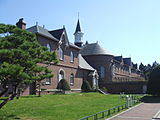Our Lady of the Angels Trappistine Abbey
 The Angels Trappistine Abbey | |
| Monastery information | |
|---|---|
| Established | 1898[1] |
| Reestablished | 1927[1] |
| Bishop | Roman Catholic Diocese of Sapporo |
| Architecture | |
| Style | Gothic and Romanesque[2] |
| Site | |
| Location | Japan 346 Kamiyukawa, Hakodate, Hokkaido |
| Other information | Off-limits to men (still, There are certain areas open to the public) |
| Website | www |
| Our Lady of the Angels Trappistine Abbey 天使の聖母トラピスチヌ修道院 | |
|---|---|
 | |
| Religion | |
| Affiliation | Trappists |
| Religious features | Abbey/Religious tourism |
| Location | |
| Geographic coordinates | 41°47′16″N 140°49′21″E / 41.78785°N 140.822514°E |
Our Lady of the Angels Trappistine Abbey Tenshi No Seibo Torasupichinu Shūdōin (天使の聖母トラピスチヌ修道院) is a women's abbey of Trappists located in the outskirts of Hakodate, Hokkaido, Japan.
This is Japan's first women contemplative order, colloquially known as "The Anjel Garden" (Tenshien[3]).
Founded by a group of eight nuns sent from France[2] in 1898,[1] After that, the building was rebuilt twice due to fires, one in 1925 and the other in 1941.[1]
Rofū Miki visited this place and wrote a lyric called 'Nobara' lit. 'Wild rose', a song composed by Kōsaku Yamada, and 'Nobara' became familiar with a Japanese song.[note 1]
Timeline[edit]
- 1896 – Due to the request of the first head of Catholic Diocese generator in Hakodate, an abbot of the Chinese Consolation Monastery determined to establish a monastery.[citation needed]
- 1898 – The eight nuns[note 2] arrived at, On 30 April, Our Lady of the Angels Trappistine Abbey was established.[1]
- 1899 – First two Japanese applicants joined in.[1]
- 1905 – The Two-story brick building was constructed that would be part of the main building's front side.[5]
- 1907 – Great fire of Hakodate occurred. At that time, some rooms were provided by Sisters of Saint Paul in Hakodate of Chartres as a refuge for orphanages who were kept eye on by nuns.[5][1]
- 1912 – The production of Dutch cream cheese had commenced. After a few years, started making butter.[5]
- 1913 – Main building and Cathedral were completed.[1]
- 1925 – First fire that occurred in October, the Cathedral, etc was destroyed by a fire.[1] After that, reestablished just in two years.[5]
- 1927 – The main building and Cathedral were restored and designed by Max Heindel who is Swiss architect.[1]
- 1932 – Monastery commune had been more than 100 people.[1]
- 1941 – Second fire that occurred in May.[5][1]
- 1948 – The 50th anniversary ceremony was held.[1]
- 1956 – Started off manufacturing and baked sweet called 'Madarena'.[1]
- 1959 – Set off production of butter candies.[1]
- 1968 – Compline and Grace (prayer) were changed from Latin to Japanese.[1]
- 1982 – Decided to establish a branch monastery in South Korea.[1]
- 1987 – Korean monastery, "Sujeong Trappist Monastery" was established.[1]
- 1998 – The 100th anniversary ceremony was held.[1]
- 2004 – The cattle barn closed, so dairy farming business ended which lasted about 90 years.[1]
- 2008 – Visitation Cathedral hosts a public 'Prayer Gathering for World Peace' event for the first time in Japan.[6]
- 2013 – Butter candy was no longer being produced.[1]
- 2016 – The ceramic relief was created in the formerly service entrance.[1]
Gallery[edit]
-
An appearance of the main building, (2008)
-
Looking up at the monastery from the bottom of the stairs, (2008)
-
View from the abbey, (2008)
-
Statue of Michael the Archangel, (2008)
Footnotes[edit]
- ^ Actually, It's Rugosa rose[4]
- ^ Members of an Abbey of Ubexy, France
See also[edit]
- Abbey of Fontenay
- トラピスト修道院 (Tobetsu Trappist Monastery)
References[edit]
- ^ a b c d e f g h i j k l m n o p q r s t u v "平和への思いいつまでも 終戦記念日、各地で追悼行事". Hakodateshimbun. 16 August 2016. Retrieved 10 January 2024.
- ^ a b "Our Lady of the Angels Trappistine Monastery: Japan's First Women's Abbey". Retrieved 10 January 2024.
- ^ https://www.trappist.or.jp/home/Tobetsu-History/Tobetsu-History-2.html
- ^ (『山田耕筰作品全集第5巻~独唱曲1 三木露風の詩による作品』春秋社)
- ^ a b c d e 天使の聖母トラピスチヌ修道院 青菁社
- ^ "平和への思いいつまでも 終戦記念日、各地で追悼行事". Hakodateshimbun. 16 August 2016. Retrieved 11 January 2024.
External links[edit]





